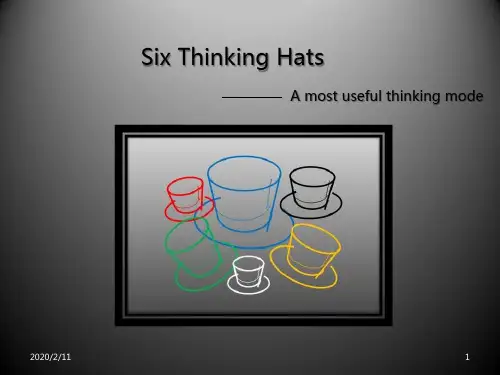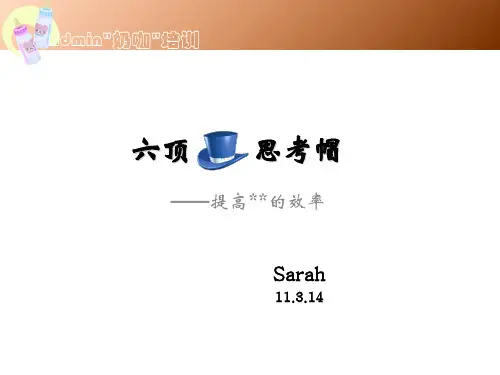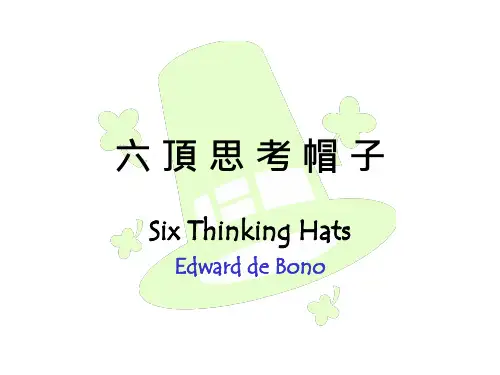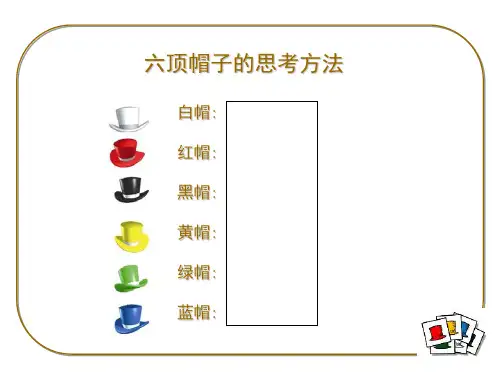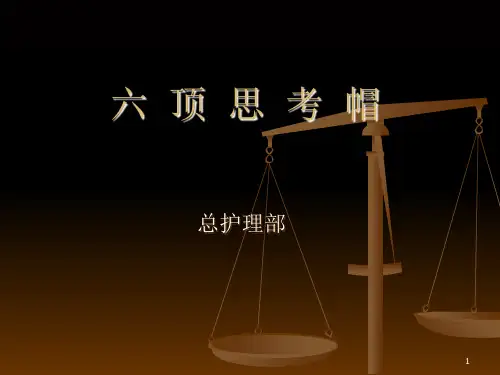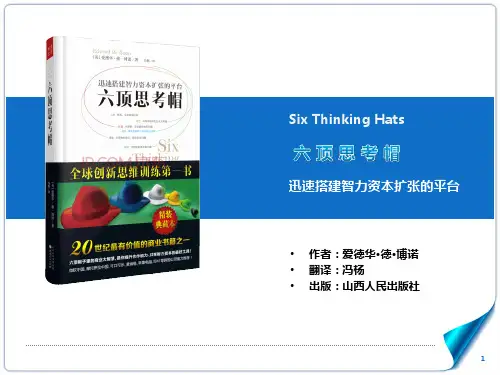- 1、下载文档前请自行甄别文档内容的完整性,平台不提供额外的编辑、内容补充、找答案等附加服务。
- 2、"仅部分预览"的文档,不可在线预览部分如存在完整性等问题,可反馈申请退款(可完整预览的文档不适用该条件!)。
- 3、如文档侵犯您的权益,请联系客服反馈,我们会尽快为您处理(人工客服工作时间:9:00-18:30)。
Six hats summary
Blue: control & organization of thinking White: objective facts & figures Red: emotions & feelings Yellow: hope, positive & speculative Green: creativity, ideas & lateral thinking Black: cautious & careful
Asking the right question
We can’t get the right answer if we ask the wrong question
Crucial blue hat skill One technique: five whys
Creative Problem Solving
The blue ቤተ መጻሕፍቲ ባይዱat role
Control of thinking & the process Begin & end session with blue hat Facilitator, session leader’s role Choreography
• open, sequence, close • Focus: what should we be thinking about • Asking the right questions • Defining & clarifying the problem • Setting the thinking tasks
Green hat
• Generate new ideas & concepts
Blue hat
• Organize ideas & process for evaluation
White, yellow & green hats
General hat issues
Direction, not description
• Set out to think in a certain direction • “Let’s have some black hat thinking…”
Not categories of people
Open with the blue hat…
Why we are here what we are thinking about definition of the situation or problem alternative definitions what we want to achieve where we want to end up the background to the thinking a plan for the sequence of hats
• Each hat identifies a type of thinking • Hats are directions of thinking
Hats help a group use parallel thinking
• You can “put on” and “take off” a hat
Uses for Six Hats
Problem solving Strategic planning Running meetings Much more
Six colors…
White: neutral, objective Red: emotional, angry Black: serious, somber Yellow: sunny, positive Green: growth, fertility Blue: cool, sky above
Six hats & problem solving
A more deliberate process than CPS Like CPS, uses creativity (green hat) Unlike CPS, provides a mechanism for
evaluating ideas & making decisions
Red Hat Thinking
Emotions & feelings Hunches, intuitions, impressions Doesn’t have to be logical or consistent No justifications, reasons or basis All decisions are emotional in the end
Hypothetical problem solving program using the hats - 1
Blue hat
• Organize the process
Red hat
• Emotional issues & feelings
White hat
• What do we know, need to know
…and six hats
White: objective facts & figures Red: emotions & feelings Black: cautious & careful Yellow: hope, positive & speculative Green: creativity, ideas & lateral thinking Blue: control & organization of thinking
Using the hats
Use any hat, as often as needed Sequence can be preset or evolving Not necessary to use every hat Time under each hat: generally, short Requires discipline from each person
Yellow hat
• Proposals & suggestions; what ifs, why nots
Hypothetical problem solving program using the hats - 2
Blue hat
• Focus on the areas that need new ideas
• While using it, stay in the idiom
Adds an element of play, play along Can be used by individuals and groups
The blue hat
Thinking about thinking Instructions for thinking The organization of thinking Control of the other hats Discipline and focus
Use in whole or in part
Benefits of Six Thinking Hats
Provides a common language Experience & intelligence of each person
(Diversity of thought) Use more of our brains Helps people work against type, preference Removal of ego (reduce confrontation) Save time Focus (one thing at a time) Create, evaluate & implement action plans
Black Hat Thinking
Cautious and careful Logical negative – why it won’t work Critical judgement, pessimistic view Separates logical negative from emotional Focus on errors, evidence, conclusions Logical & truthful, but not necessarily fair
we know, what do we need to know Excludes opinions, hunches, judgements Removes feelings & impressions Two tiers of facts
• Believed Facts • Checked Facts
“Traditional” CPS
Mess-finding Data-finding Problem-finding Idea-finding Solution-finding Acceptance-finding
Common idea-finding methods
Brainstorming Mind Maps Free association Freewriting Incubation
Creative Problem Solving with
Six Thinking Hats
How to use Edward deBono’s parallel thinking in problem solving
Goals of this program
Define parallel thinking Identify each of the six hats Learn how to ask a good question Apply six hats method to problem solving
